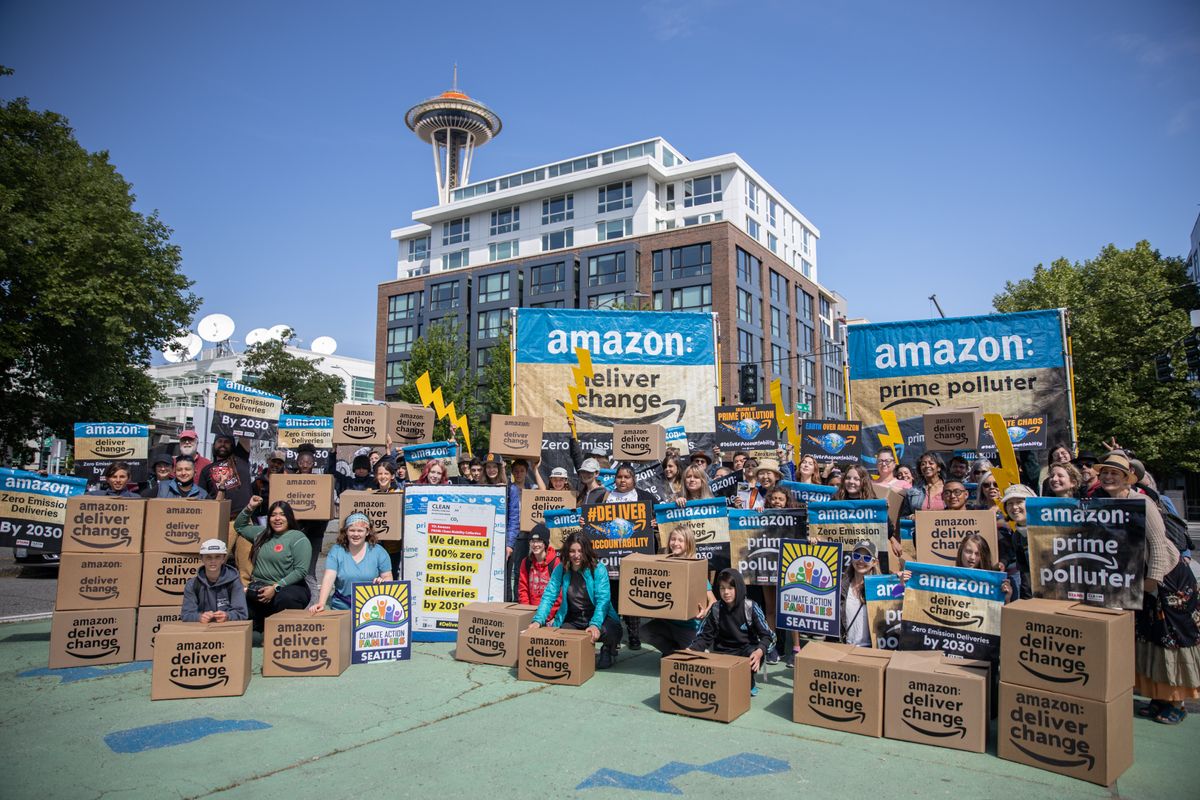IE groups visit Amazon HQ in Seattle to call on company to #DeliverChange

A joint report shows Amazon makes billions of package deliveries annually. If the company fails to commit to zero-emissions, authors argue, it could impact the health and lives of their workers
Coinciding with the release of the new “Cost of Convenience” joint report by the Clean Mobility Collective (CMC) and the Stand.earth Research Group (SRG), climate justice and labor organizers from the Inland Empire joined several dozen advocates outside of Amazon’s headquarters in Seattle, Washington, on May 23, to call on the company to #DeliverChange.
Members of the People’s Collective for Environmental Justice (PC4EJ), Teamsters Local 1932, the Warehouse Workers Resource Center and IE Amazon Workers United all attended the press conference at the global retailer’s doorstep and later paid a visit to executives inside.
They delivered a set of demands, imploring the multibillion-dollar corporation to achieve zero emissions on their last mile truck deliveries by 2030. The “last mile” is not always a one-mile journey but it is a relatively short trip at the end of the chain, as noted in a CMC/SRG press release.
Andrea Vidaurre, senior policy analyst with the PC4EJ, said they made the trip not only because Amazon is one of the biggest contributors to pollution in the logistics sector, but also because of the harm the business delivers locally.
“Amazon has its largest concentration of warehouses in the Inland Empire, which means thousands upon thousands of [their trucks drive] through our neighborhoods,” Vidaurre said. “And since they're such a big company, they actually influence a lot of the ways that other logistics companies operate.”
According to an estimate in the joint report, Amazon Logistics and five other firms now deliver more than 25 billion parcels per year. The study authors predict that number could reach 64 billion by 2030, and if fleet makeup does not change, the combined emissions from these six companies could result in 13,500 instances of exacerbated asthma and as many as 23,000 cases of respiratory problems in the next seven to eight years.
Assuming no changes in fleet makeup, they predict the last mile emissions of all delivery companies could lead to as many as 168,000 cases of exacerbated asthma, 285,000 cases of respiratory symptoms and 9,500 premature deaths by 2030.
As pointed out in "Cost of Convenience" all of the zero-emission pledges offered by Amazon so far are not enough to account for the company's anticipated increase in annual deliveries by 2030. Complicating matters, Amazon just nixed its “Shipment Zero” pledge to make half of all its shipments net-zero carbon in the next seven years, as Will Evans, a journalist with Reveal, and later Business Insider, both documented. According to a statement from Amazon, the company “realized that it no longer made sense to have a separate and more narrow Shipment Zero goal” applicable to just a part of its business.
Amazon maintains a “Climate Pledge” to reach net-zero carbon emissions come 2040.
“‘Net-zero emissions’ targets allow companies to offset emissions; however this cannot replace needed emissions reductions and fossil fuel phase-outs,” the CMC/SRG report authors argue.
The report calls on Amazon and others to commit to zero greenhouse gas emissions by 2030.
Eliza Pan, a former Amazon employee based in Seattle who remains active with Amazon Employees for Climate Justice, said her previous employer has many more resources than most and a responsibility to decarbonize faster.
“Amazon's carbon footprint is vastly underreported,” Pan added.
Compared to corporate peers like UPS and FedEx, Amazon discloses the least amount of reliable data on last mile deliveries, according to the CMC/SRG study.
Based on Amazon’s 2021 Sustainability Report and other estimates, the “Cost of Convenience” investigation also found less than one percent of company deliveries in the US were made via electric vehicles (EVs) or various mobility modes, and existing EV pledges only amount to about half of its delivery volume at present. Amazon fails to account for the growing e-commerce market in their estimates, per the CMC/SRG document, and available data suggests the existing EV commitments from the company founded in 1994 by the now third richest individual in the world will only account for 20 to 30 percent of projected parcel deliveries in 2030.
The electric delivery vehicles the retailer has promised do not appear adequate “enough to handle the minimum projected increase in Amazon’s annual deliveries from 2021 to 2030,” the authors of the study noted.
They recommend Amazon and its peers develop plans that prioritize transition to electric vehicles and zero emission options in communities with poor air quality and the worst pollution.
One Inland Empire-based Amazon employee, who in concern of retaliation chose to speak to The Frontline Observer in anonymity, echoes the author’s sentiments. They support the work of groups like IE Amazon Workers United and hope they continue to pressure the employer to pay living wages, refrain from retaliation in response to labor organizing and mitigate its environmental impact, especially in the Inland Empire.
“They need to focus more on the communities they reside in,” they said about Amazon’s climate justice efforts, and lack thereof. “We should definitely do the zero emissions first in the communities they're in because we are breathing it in [when they emit].”
